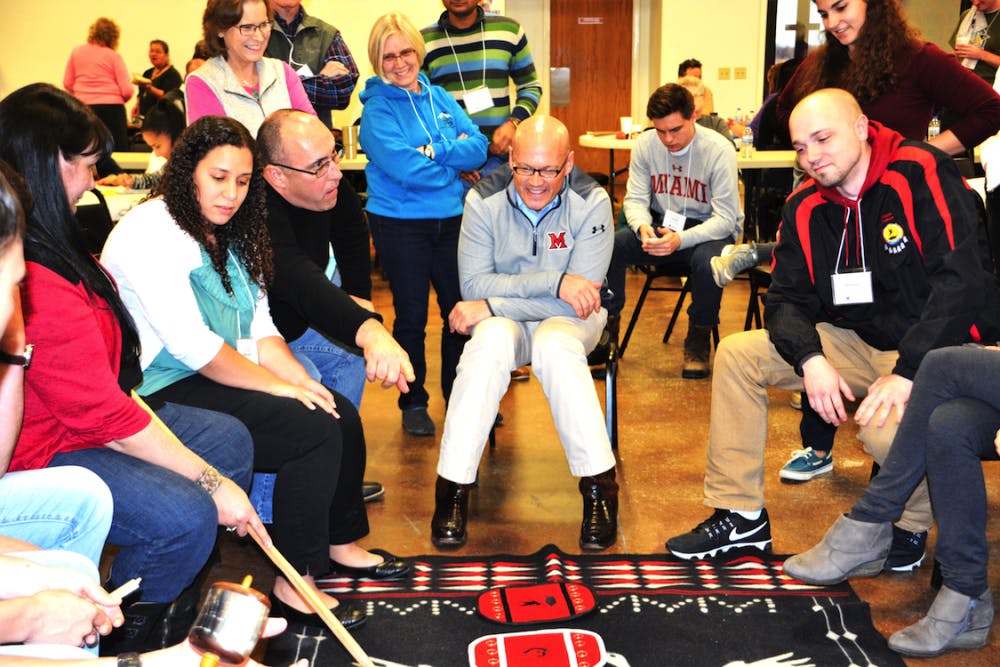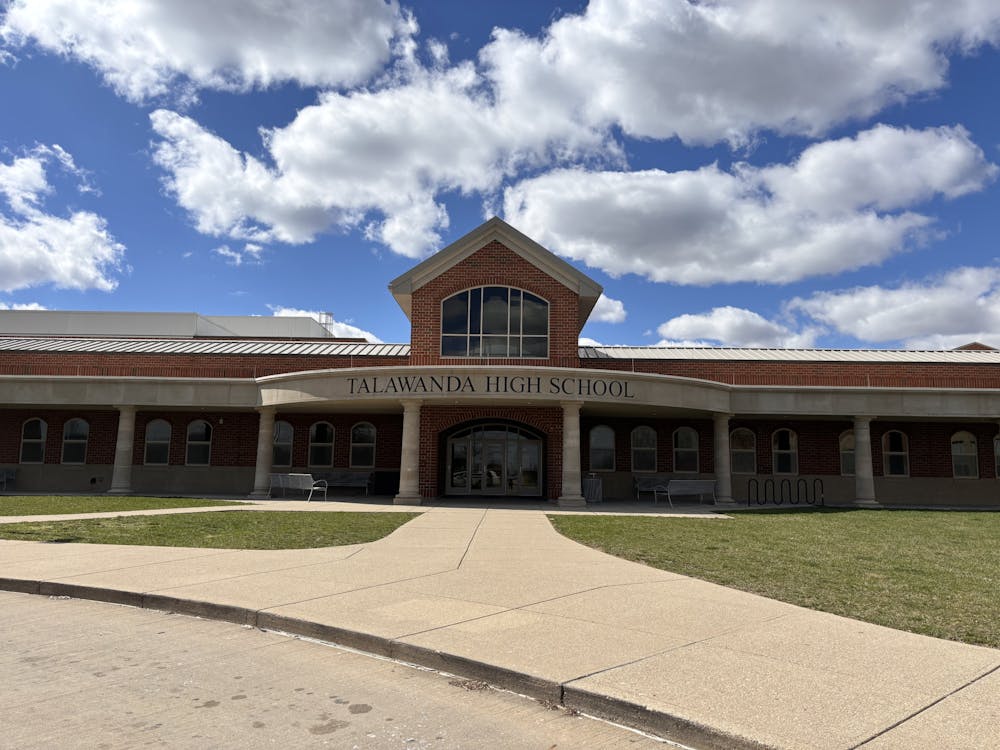Crawfords participate in Miami Tribe's annual Winter Gathering
On Friday morning, Miami University's president and ambassador, Greg and Renate Crawford, boarded the university's plane, bound for another Miami -- Miami, Okla. (pronounced my-am-uh), a small town of about 14,000 residents along the historic Route 66 and the national headquarters of the Miami Tribe of Oklahoma.
This weekend marked the Crawford's first visit to the tribe's headquarters. About 50 Miami students, faculty and staff members also made the trip southwest to join the tribe for their annual Winter Gathering and Stomp Dance.
For over 40 years, Miami University and the Miami Tribe of Oklahoma have developed their partnership. The university carries the name of the tribe whose homelands are located in parts of Indiana, Ohio, Illinois, lower Michigan and lower Wisconsin.
Since 2013, the Myaamia Center, located in Bonham House on Spring Street, has been the cornerstone of that relationship. The center has been the site of linguistic and cultural research and the development of educational programs and materials related to the tribe.
Friday afternoon, Douglas Lankford, chief of the Miami Tribe, introduced the Crawfords at the Miami Nation's Council House. Lankford thanked them for making the trip and presented them with a handmade Myaamia blanket.
"Without the university, we would not be where we are today," Lankford said.
Greg offered framed photos of Lankford and Daryl Baldwin, the director of the Myaamia Center, at his inauguration in October as well as a medal for the tribe to symbolize the importance of their partnership.
During their stay, the Crawfords had accommodations at the Gordon House, a home built in 1917 by tribal member Emma Gordon McBee. When it was built, the three-story structure was one of the finest homes in Miami and continues to be one of the most historically notable sites in the area.
The Gordon family, who acquired their wealth from mining royalties, used to sneak African American bands from Kansas City to their home to perform at dances they held in their third floor ballroom. During World War II, the home was sold to the government and housed members of the British Air Force.
"It was really an honor to stay in the Gordon House," Renate said. "It's really beautiful. It shows [the tribe's] pride in their history."
Throughout the weekend, the Crawfords were invited to not only discuss the tribe's culture and traditions, but to actively participate -- something which, Chief Lankford noted, they seemed extremely eager to do.
Enjoy what you're reading?
Signup for our newsletter
"I'm very pleased they were able to come here during their first year at the university. It shows engagement with the tribe," Lankford said. "People have commented how friendly, how personable they are. [Greg] wears his cowboy boots -- he fits in down here."
Greg also met with members of the Miami Tribe's business committee and took a bus tour of the tribe's properties and facilities. He sees opportunities for even more collaboration between the tribe and the university, he said, from further research about the Myaamia language to environmental projects.
Lankford noted that they discussed the possibility of bringing tribal business and legal representatives to host workshops for Miami students. These would be geared towards engaging students in business ventures with the country's 566 legally recognized Native American tribes.
Rachel Poyfair, a senior Myaamia student, was impressed by the enthusiasm and sincere interest she saw from the Crawfords throughout the weekend.
"It was enriching as a student to see that even the president of my university is interested in my experience here," Poyfair said. "I'm coming back from a weekend that was with the president celebrating my culture -- that just deepens my connections at Miami even more."
Coming into the weekend, Greg was looking forward to hearing the tribe's winter stories. Passed down through oral tradition, these stories can only be told from the first winter frost until spring's first thunderstorm.
Miami tribe members and their guests from Miami University gathered in the tribe's Council House Friday evening to hear these stories, some told in English, but others told in Myaamia. The meanings of these stories are not constrained to a single interpretation, but rather can mean something different to each listener, or even change as the listener hears the stories over time.
"That's not something we're necessarily used to. It makes you think, 'What do you get out of it? How do you feel about it.' That was really intriguing," Renate said.
They were both struck by how engaged the children were with the Myaamia stories.
"They were just sitting there and they were so taken with those stories," Greg said. "Their eyes were focused on the storytellers."
"The other thing I was really impressed with that everything there at least that we experienced was very intergenerational," Renate said. "The elders are very respected and the children are taken in at a very early age."
The weekend's events culminated at the tribe's annual Winter Social Gathering where Miami tribe members as well as members from other nearby tribes participate in a gourd dance and stomp dance. During the stomp dance, everyone is encouraged to participate.
Each dance proceeds in the same way -- a male "caller" leads the dance followed by a female "shaker." The women set the rhythm of the dance by stomping and shaking the shells worn around their ankles. Traditionally, the shakers were made from turtle shells but are typically now made from cans filled with small stones. The dancers, alternating male and female, continued to form a spiral as more people joined the dance.
The Crawfords watched the first few dances from their seats, but, for the rest of the evening, if they weren't meeting tribe members or talking with students, they were in the center of the room stomping in time to the shaker's steps.
"What I liked about the stomp dance was everything we talked about, it was there," Renate said. "When you're watching it is one thing, but when you're in it it's an intense experience and I hadn't expected that. You're taking it all in and think, 'I'm part of this.'"
Being immersed in the Myaamia culture in Oklahoma was a very different experience from learning about the tribe while in Oxford, Renate said.
"I think for me it became more personal. You could see the personal aspect of it and how it affected families," Renate said. "Hearing these little children speaking the language and seeing revitalization of the culture -- it's emotional seeing that come back and being a part of that"




